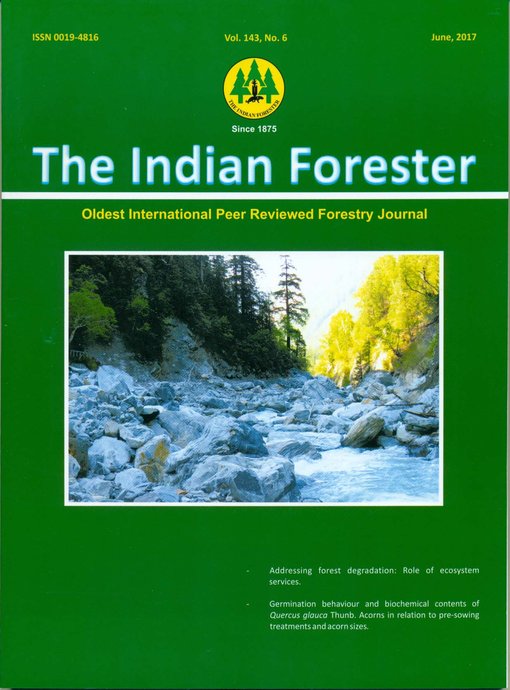Weed Diversity in North-East Part of Belgavi District, Karnataka (India)
DOI:
https://doi.org/10.36808/if/2017/v143i6/115845Keywords:
Flora, Weed, Belgavi, Karnataka, India.Abstract
In present investigation,a total number of 116 weeds species under 90 genera belonging to 33 families were recorded and analyzed. Among 33 families, Asteraceae, Poaceae and Euphorbiaceae were found dominated with 20, 17 and 11 respectively. Among total number of species, some species like Parthenium hysterophorus, Cyperus rotundus, Euphorbia heterophylla, Ageratum conyzoides, Sonchus oleraceus, Amaranthus viridis, Tridax procumbens, Solanum nigrum and Dinebra retroflexa were found most successful regenerative species. Based on the phytosociological analysis, it is indicated that the study area comprises variety of weed species and it's important to understandthe weed diversity within a field will be useful to observe the changes in cropland ecosystem.References
Bandiwadder T.T., Itnal C.J. and Chetti M.B. (2001). Weed control studies in Soybean. Karnataka J. Agricultural Science, 14(2):456-458.
Bhan V.M. and Sushilkumar (1998). Weed Science research in India. J. Indian Agricultural Sciences, 68(8):567-582.
Blatter E. and McCann C. (1984). The Bombay Grasses. Bisen Singh Mehandra Pal Singh, Dehradun. (Rep. Ed.)
Channappagoudar B.B., Biradar N.R., Bharmagoudar T.D. and Koti R.V. (2007). Crop Weed Competition and Chemical Control of Weeds in Potato. Karnataka J. Agricultural Science, 20(4):715-718.
Cooke T. (1958). The Flora of Presidency of Bombay. Vol. I-III. Bisen Singh Mehandra Pal Singh, Dehradun. (Rep. Ed.)
Curtis J.T. (1959). The vegetation of Wisconsin: An ordination of plant communities. University Wisconsin Press, Madison, USA.
Curtis J.T. and McIntosh R.P. (1950). The interrelation of certain analytic synthetic phytosociological characters. Ecology, 31:43-445.
Haji I.D., Hunshal C.S., Malligwad L.H., Basavaraj B. and Chimmad V.P. (2012). Effect of pre and post emergence herbicides on weed control in maize (Zea mays L.), Karnataka J. Agricultural Science, 25(3):392-394.
Hegde N.K. (1998). Crop diversification studies in areca nut (Areca catechu L.) plantation, Ph.D. thesis, University of Agricultural Sciences, Dharwad, Karnataka.
Jain S.K. and Rao R.R. (1977). A hand book of field and herbarium methods. Today and Tomorrow's Printers and Publisher's, New Delhi.
Mallikarjunappa R.S. and Razi B.A. (1976). Studies on weeds of areca nut gardens of Mysore and Shimoga District and Enumeration of weeds. J. Mysore University, 27:212-226.
Murphy S.D., Clements D.R., Belaoussoff S., Kevan P.G. and Swanton C.J. (2006). Promotion of weed species diversity and reduction of weed seed banks with conservation tillage and crop rotation. Weed Science, 54:69-77.
Odum E.P. (1971). Fundamentals of Ecology. Nataraj Publishers, Dehradun.
Palmer M.W. and Maurer T.A. (1997). Does diversity beget diversity? A case study of crops and weeds. J. Vegetation Science, 8:235-240.
Panse V.G. and Sukhatme P.V. (1985). Statistical methods for agricultural workers. Indian Council of Agricultural Research, New Delhi.
Prayaga Murty P. and Venkaiah M. (2011). Biodiversity of Weed Species in Crop Fields of North Coastal Andhra Pradesh, India. Indian J. Fundamental and Applied Life Science, 1:59-67.
Reddy C.S., Bagyanarayana G., Reddy K.N. and Raju V.S. (2008). Invasive alien flora of India. National Biological Information Infrastructure, USGS, United States of America.
Saldanha C.J. (1984). Flora of Karnataka. Vol. 1. Oxford and IBH publishing Co. New Delhi.
Saldanha C.J. (1996). Flora of Karnataka. Vol. 2. Oxford and IBH publishing Co. New Delhi.
Samanta P., Senapati T., Mukherjee K.A., Mondal S., Haque S. and Ghosh A. R. (2010). Effectiveness of Almix in controlling aquatic weeds and fish growth and its consequent influence on water and sediment quality of a pond. The Bioscan, 3(Supplement): 691-700.
Shahapurmath G.B., Shivanna H. and Girisha H.V. (2003). Studies on Weed Intensity in Existing Arecanut Based Agroforestry Models. Karnataka J. Agricultural Science, 16(2):260-264.
Singh N.P. (1988). Flora of Eastern Karnataka. Vol. 1 & 2. Mittal Publications. New Delhi.
Sudha T., Nanjappa H.V., Ramachandrapa B.K., Mudalagiriyappa and Mallikarjuna G.B. (1997). Weed control in Chilli and Capsicum nursery by soil solarization. Karnataka J. Agricultural Science, 10(4):1177-1180.
Vanitha K., Srikumar K.K., Bhat P. S. (2014). Record of weed flora of cashew plantations as hosts of tea mosquito bug. The Ecoscan, 8(3&4):221224.
Yadav S.R. and Sardesai M.M. (2002). Flora of Kolhapur District. Shivaji University, Vidyanagar, Kolhapur, Maharashtra.
Downloads
Downloads
Published
How to Cite
Issue
Section
License
Unless otherwise stated, copyright or similar rights in all materials presented on the site, including graphical images, are owned by Indian Forester.





